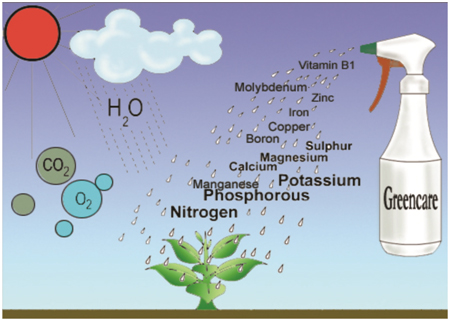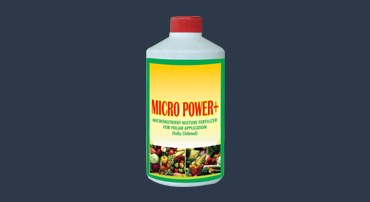
Pachila mark Micropower is a balanced combination of micro and secondary plant nutrients formulated to supply Boron, Chlorine, Copper, Iron, manganese, Molybdenum, Magnesium, Sulphur etc along with vitamins to plants for healthy growth and sustained high yield.
Though these are present only in small quantities, they are also equally important and necessary from nutritional point of view. Micronutrient deficiencies are widespread .Modern methods and innovative techniques are imperative in smart farming which is the need of the hour to enhance the crop production and productivity in sustainable agriculture
Soils are seldom able to furnish all the nutrients that a crop requires. Carbon, Oxygen and Hydrogen are available to plants from nature and the requirement of other nutrients is to be met by application of commercial fertilizers. As Nitrogen, Phosphorous and Potassium are utilized by plants in considerable quantities the soil generally is deficient in these nutrients. Hence, the fertilizer industry in the country concentrates only in the production of Nitrogenous, Phosphatic and Potassic fertilizers for N. P. & K requirements of plants. But the use of N. P. & K fertilizers alone is found to be not sufficient to improve the yield of crops. The secondary and micronutrients are also found to play a key role in increasing fertilizer use efficiency and to improve crop production and productivity.
Calcium, Magnesium and Sulphur are popularly known as secondary nutrients because of their requirement being less than that of primary nutrients. Nevertheless, from nutrition point of view, they are indispensable like any other essential nutrient. Nutritional aspects of secondary and micronutrients have not been given adequate attention as needed so far. This calls for proper study of the situation and creation of awareness of the necessity of these elements under intensive cropping system in order to achieve crop production target.
The below depiction shows the essential nutrients that the plant requires for a healthy life and how they can be made available to plants through foliar application. The requirement of Oxygen, Carbon and Hydrogen are available in nature. Other elements like Primary (N.P.K), Secondary (Ca, Mg & S) and Micronutrients (B, Cu, Mn, Fe, Mo, Zn, Cl etc. are to be provided through application of approved ingredients in the soluble form

The returns of applying micronutrient-enriched fertilizers could be huge for human health, social and economic development. Research has shown that enriching fertilizers with micronutrients had not only an impact on plant deficiencies but also on humans and animals, through the food chain. A 1994 report by the World Bank estimated that micronutrient malnutrition costs developing economies at least 5 percent of gross domestic product. The Asian Development Bank has summarized the benefits of eliminating micronutrient deficiencies as follows:
Along with a growing understanding of the extent and impact of micronutrient malnutrition, several interventions have demonstrated the feasibility and benefits of correction and prevention. Distributing inexpensive capsules, diversifying to include more micronutrient-rich foods, or fortifying commonly consumed foods can make an enormous difference. Correcting iodine, vitamin A, and iron deficiencies can improve the population-wide intelligence quotient by 10-15 points, reduce maternal deaths by one fourth, decrease infant and child mortality by 40 percent, and increase people’s work capacity by almost half. The elimination of these deficiencies will reduce health care and education costs, improve work capacity and productivity, and accelerate equitable economic growth and national development. Improved nutrition is essential to sustained economic growth.5 Micronutrient deficiency elimination is as cost effective as the best public health interventions and fortification is the most cost-effective strategy.
Dissolve 25 gms Micropower in 15 Ltrs of water for infant plants and 25 gms of micropower in 10 Ltrs of water for mature plants. Apply the solutions as often as watering is required by spray, drip feed or manual methods.
| Zinc (as Zn) | 2.0% |
| Manganese (as Mn) | 0.4% |
| Magnesium (MgO) | 8.5% |
| Boron (as B) | 0.6% |
| Calcium (as Ca) | 0.5% |
| Copper (as Cu) | 1.5% |
| Ferrous (as Fe) | 1.1% |
| Sulphur (as S) | 15.0% |
| Molybdenum (as Mo) | 0.02% |
Micropower is available in 250 gm packing.

